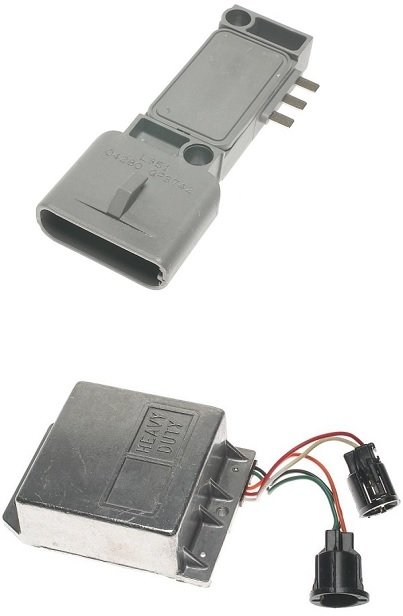Fuel pumps in the tank are not common with carburetors, so I wasn't sure why you had two of them. The only time I've run into that was on the Chevy Chevettes. Also be aware you can buy most in-tank fuel pumps two ways. Most people go for the less-expensive pump and motor only that gets transplanted into the housing. The screen gets reused / overlooked. When the entire housing is available with the pump already in it, that comes with a new screen, but it's usually still a lot less expensive to buy just the pump and motor, then buy a new screen separately.
If you think this isn't fuel-related, (keep in mind revving the engine in neutral requires very little gas compared to hard acceleration on the road), the next suspect might be a tight universal joint. I ran into this when my boss was looking at buying a used Ford van for his TV repair shop. I know this sounds strange, but we couldn't get the van to go faster than 55 mph with it floored. Finally at the end of one test-drive, we heard a little squeaking from the rear u-joint that gave it away. The dealer had both u-joints replaced, then acceleration was back to normal. Since then I've run into that a few more times. The only thing different is there was no sputtering.
Consider watching what happens to ignition timing when you raise engine speed. If it advances in steps, but keeps advancing, the advance weights in the distributor are sticking. If timing bounces back and forth, especially while holding engine speed mid-range and steady, suspect a worn bushing in the distributor or a stretched timing chain. Normally these two things cause surging, but you can still reach highway speed.
Another weird one had to do with a dry-rotted rubber hose inside the tank on Ford Tempos. I never had one apart so you'll have to visualize this. The symptom was the engine would run fine as long as the tank was at least half-full of gas. When the level dropped below that, air would intermittently get sucked in. The symptom was it acted like it was running out of gas.
Had an old late '60s Pontiac wagon that ran fine around town, but stalled when trying to accelerate to highway speed. Ended up being the hood silencer pad was falling down and blocking the inlet on the air filter housing.
Ford had horrendous problems with their front brake calipers. Their design and how they're held to the mounting knuckle is asking for trouble with sticking brakes. I worked at a Sears Auto Center in the '80s. We rebuilt the calipers and wheel cylinders as a part of every brake job. We even had an almost-new Ford van come in from out-of-state with smoking front brakes at 7,000 miles. The local Ford dealer told the fellow there was nothing they could find wrong, and warranty doesn't cover brakes. We also had a half dozen Ford vans for the service department. We were replacing brakes on those all the time. Before you go looking for the hard stuff, check for badly-dragging brakes and rule that out as a possible cause. Stop on a slight incline, shift to "neutral", then see if it creeps down-hill on its own.
The point is, ... This is very unlikely to be a spark-related problem. You need spark, fuel, compression, and correct timing of all the events. Compression isn't going to be intermittent or speed-sensitive. Ignition timing will cause reduced power and fuel mileage, but it won't limit maximum speed this badly. I think you would have noticed problems with the brakes, so that leaves fuel. Check if the secondaries are opening up on the carburetor. You don't need them to raise engine speed in "neutral", but you do to get up to highway speed. If the secondaries aren't opening up, that's still a fuel problem, but not a problem with the fuel supply system or fuel pressure.
Friday, March 27th, 2020 AT 7:27 PM




